There was no soundtrack album when 101 Dalmatians premiered 60 years ago, nor would there be for almost four decades.

WALT DISNEY’S
101 DALMATIANS
Classic Soundtrack Series
Walt Disney Records 60654-7 (Compact Disc / Mono)
Released in 1998. Restoration Producer/Digital Editor: Randy Thornton. Digital Restoration Executive Producer: Ted Kryczko. Musical Director: George Bruns. Audio Research: Scott McQueen, Glenn Ragland. Restoration/Mastering: John Polito. Art Direction: Luis Fernandez. Design: Janet Wilson, Marcella Wong. Illustrations: Phillippe Harchy Studios. Running Time: 57 minutes.
Vocalists: Bill Lee, Lucille Bliss.
Songs: “Kanine Krunchies Kommercial,” “Cruella De Vil,” “Dalmatian Plantation” by Mel Leven.
Instrumentals: “Overture,” “A Beautiful Spring Day,” “What’s All the Hurry,” “A Perfect Situation,” “Stir Things Up,” “Don’t Worry, Perdy,” “The Puppies Are Here,” “Lucky How Marvelous,” “Not One,” “A Bloomin’ Hero,” “Ol’ Thunder Always Wins,” “Bedtime / An Evening Constitutional,” “A Job To Do,” “They’re Gone!” “Dognapped!” “Anita Darling,” “What’ll We Do? ” “All Dog Alert,” “Sergeant Tib’s Recon,” “Cat Casserole,” “Can You Leave Tonight?” “Arduous Trek,” “Any News, Colonel?” “I Want the Job Done Pulling a Snitch,” “Big Hullabaloo,” “Battling the Baduns,” “My Darlings,” “99,” “Better Be Off,” “Fire One,” “All Clear,” “Through the Snow,” “Shelter,” “I’m Hungry,” “Get Some Rest,” “Back on the Road,” “Spotted!” “Dinsford,” “Cruella,” “A Roll in the Soot,” “To the Van,” “It Can’t Be,” “Crazed,” “You Fools!” “Puppies Everywhere” by George Bruns.
When an entertainment production is planned, among the business decisions are the various ways consumers will enjoy it in various other media formats. None of this is by chance because everything involves people, fees and contracts.
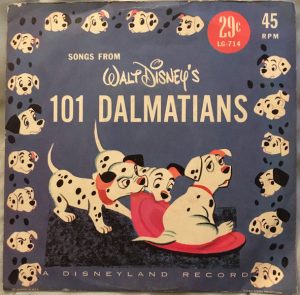 In several Animation Spin articles, there have been histories of films and shows that do not or did not have soundtrack recordings for any number of reasons, but the answers all start with the initial agreements as to who will or will not produce them. Walt Disney’s Alice in Wonderland, for example, was contracted to Decca Records, but no soundtrack was released. Rather than incurring the fees again, especially as the film was not a box office success in the early fifties and the songs were determined to be too fragmented in the film for an album format of the era, it was decided to completely reinterpret the score. Disneyland Records’ 1957 budget allowed for a substantial orchestra and chorus and the results were spectacular.
In several Animation Spin articles, there have been histories of films and shows that do not or did not have soundtrack recordings for any number of reasons, but the answers all start with the initial agreements as to who will or will not produce them. Walt Disney’s Alice in Wonderland, for example, was contracted to Decca Records, but no soundtrack was released. Rather than incurring the fees again, especially as the film was not a box office success in the early fifties and the songs were determined to be too fragmented in the film for an album format of the era, it was decided to completely reinterpret the score. Disneyland Records’ 1957 budget allowed for a substantial orchestra and chorus and the results were spectacular.
Each case is different, of course, but usually is traced back to the initial contractual clearance for commercial recordings. It can also be an artistic choice. Henry Mancini, who we discussed in the previous Spin about The Pink Panther, famously eschewed soundtrack albums for the RCA Victor albums of his movie scores. Instead, he arranged specific, individual tracks (each with its own beginning, middle and end as opposed to film tracks that might need to stop and start to follow visual action) with the home and radio listener in mind. Rich in themes and catchy hooks, his background music could then exist as a light jazz/easy listening album as well as soundtrack. It was only around the turn of this century that Mancini transitioned to the soundtrack format with the advent of compact discs, followed by labels such as La-La Land releasing expanded box sets of his scores with both the album and film versions.
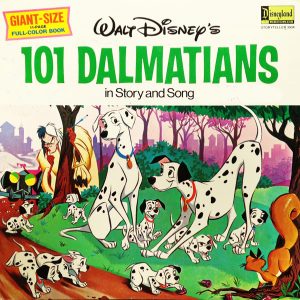 Disney animation and Disneyland Records were both in dramatic transition when 101 Dalmatians was in preparation, production and release. Neither division had spared any expense on Sleeping Beauty and the film’s initial letdown in box office returns caused Walt and Roy to question the continuation of both, at least in their previous incarnations. The animation division had lost money and the record division had not shown a profit, though Annette was helping to save it with hit records (see this Spin). The Disneyland label lowered costs and redirected its marketing specifically to kids, with the recent Buena Vista label for adults and teens. A wider selection was being created with most of the individual items made at more modest budgets.
Disney animation and Disneyland Records were both in dramatic transition when 101 Dalmatians was in preparation, production and release. Neither division had spared any expense on Sleeping Beauty and the film’s initial letdown in box office returns caused Walt and Roy to question the continuation of both, at least in their previous incarnations. The animation division had lost money and the record division had not shown a profit, though Annette was helping to save it with hit records (see this Spin). The Disneyland label lowered costs and redirected its marketing specifically to kids, with the recent Buena Vista label for adults and teens. A wider selection was being created with most of the individual items made at more modest budgets.
Disney had always been where the public sought straightforward fun and escape, and based on the response to 101 Dalmatians, it was the right property at the right time. The film was loose, funny and heartfelt—and so was the Storyteller album released by Disneyland Records, a modestly-budgeted radio-drama style recreation of the movie story narrated by Ginny Tyler and featuring some members of the cast including Betty Lou Gerson as Cruella De Vil and J. Pat O’Malley as both Horace and Jasper. Replacing David Frankham as Tibbs is Disneyland regular Dal McKennon (probably because he was already doing multiple voices for the LP, as well as for the label). Instead of Rod Taylor as Pongo, the role may very well have been voiced on the album by actor/singer Jack Cassidy (Bob Cratchit in Mister Magoo’s Christmas Carol). More about this in another Animation Spin.
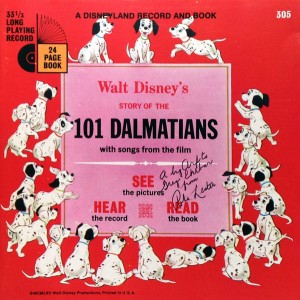 Delightful as the Storyteller version is, it does not offer the wonderful score by George Bruns nor the vocals by Lucille Bliss and Bill Lee (though he is in the vocal ensemble). It must have been decided that 101 Dalmatians was a story film and not a musical. The fact that was so successful for so many years as a “studio” or “second cast” album supports this decision.
Delightful as the Storyteller version is, it does not offer the wonderful score by George Bruns nor the vocals by Lucille Bliss and Bill Lee (though he is in the vocal ensemble). It must have been decided that 101 Dalmatians was a story film and not a musical. The fact that was so successful for so many years as a “studio” or “second cast” album supports this decision.
It wasn’t until Mary Poppins that things at the in-house Disney record company really turned around for good (find out how in this Spin), but even then, Walt was soon to pass and with him the loss of an era.
Things changed in the nineties because Walt Disney Records was infused with the success of the “Disney Renaissance” of musical powerhouse films like Beauty and the Beast, The Little Mermaid, Aladdin and The Lion King, all films with scores that fortified the music division the way Mary Poppins did, many times over. Producer and historian Randy Thornton seized the opportunity to bring long-neglected soundtracks off the shelves and into the homes of waiting listeners.
101 Dalmatians was one of them. For the first time, all the music from the film was heard in the style of a soundtrack/score album, with the assistance of renowned cinematic restoration master, Scott McQueen.
“Cruella De Vil” – Bill Lee
Randy Thornton did have to make a few small adjustments, as he described in the liner notes:
“When I restore a classic soundtrack, I try to stay close to the composer’s original intent and allow the music to progress naturally. For this reason, I took some liberties, particularly with the song. “Cruella De Vil,” because of the nature of its composition. You may recall the scene in the movie in which Roger is composing a bluesy little melody when suddenly Cruella drives up. At that moment Roger makes Cruella the subject of his song. He sings his new composition to Anita, who banishes him upstairs as the villainess enters their home. During Anita and Cruella’s visit, Roger continues to play the tune on the piano—and on various other instruments—in the attic. As I reconstructed this sequence, I found the piano piece whole and intact. To duplicate the film, I edited in the other instruments which had been separately recorded. After replicating the scene, I discovered that without the movie’s visuals to accompany the music, the horn edits were distracting. So I decided to leave the piano track alone. It may not be the way the piece appears in the film, but I believe you’ll find it more listenable as a soundtrack album.”
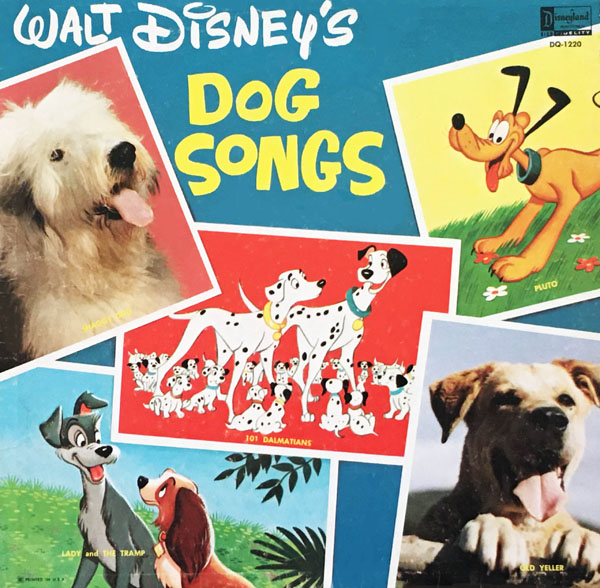
WALT DISNEY’S
DOG SONGS
Disneyland Records DQ-1220 (Compact Disc / Mono)
Reissue: Disneyland Double Feature DDF-2 (with Incredible Journey)
Released in July 1961. Executive Producer: Jimmy Johnson. Running Time: 25 minutes.
Performers: Teri York, Bob Grabeau, Roberta Shore, Jerome Courtland, Paul Frees, The Mellomen, Camarata Orchestra.
Songs from Films:
Lady and the Tramp: “Lady,” “Bella Notte,” “La La Lu” by Peggy Lee and Sonny Burke; “Home Sweet Home” (Traditional).
The Shaggy Dog: Title Song by Paul J. Smith and Gil (Hazel) George.
Old Yeller: Title Song by Oliver Wallace and Gil (Hazel) George.
Songs Based on Films:
Lady and the Tramp:The Shaggy Dog: “Doggone It, It’s a Dog,” You’re My Friend,” “Shaggy Dog Cha Cha Cha” by Camarata and William Donaldson “By” Dunham;
101 Dalmatians: “One Hundred and One Dalmatians” by Richard M. Sherman and Robert B. Sherman.
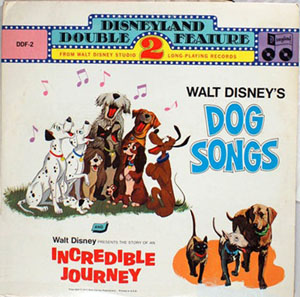 This album contains none of the four songs heard in the film, 101 Dalmatians (including “Playful Melody,” which has lyrics but is only heard in the movie as an instrumental), but instead begins side one with a tune by the Sherman brothers undoubtedly written with the film in mind but unused except on records.
This album contains none of the four songs heard in the film, 101 Dalmatians (including “Playful Melody,” which has lyrics but is only heard in the movie as an instrumental), but instead begins side one with a tune by the Sherman brothers undoubtedly written with the film in mind but unused except on records.
Had the Shermans’ “One Hundred and One Dalmatians” accompanied the opening titles, it would have been their first song in a Disney animated feature, before The Sword in the Stone. The tune also showed up on a 101 Dalmatians read-along book and record set in 1965. The remaining songs are from previous Disney films and Disneyland records, except perhaps “Sweet Adeline,” sung with canine howls by the Mellomen in the style of “Home Sweet Home” as heard in Lady and the Tramp. It was either the unreleased “B” side of a single or made for this album. Camarata versions of Lady and the Tramp tunes dominate the LP, though most of its score is not especially dog-specific.
Several are from the delightful Songs of the Shaggy Dog comedy disc with Paul Frees and Roberta Shore. The earliest recording is “Old Yeller” from 1957. It seems odd that they seem to have sought out as many dog songs as possible yet avoided any from the 101 Dalmatians storyteller itself.
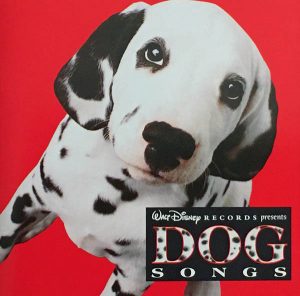 Dog Songs was “updated” (that is to say, it has the same title) by Walt Disney Records in 1996 when the first live-action remake of 101 Dalmatians was released. Except for Dr. John’s big band strutting version of “Cruella De Vil” from the remake (which was a go-to version in live character appearances), this album (60870-7) is a popular music collection, and a remarkably eclectic one at that. Instead of being bound to a specific musical sound, it runs the gamut of eras and styles.
Dog Songs was “updated” (that is to say, it has the same title) by Walt Disney Records in 1996 when the first live-action remake of 101 Dalmatians was released. Except for Dr. John’s big band strutting version of “Cruella De Vil” from the remake (which was a go-to version in live character appearances), this album (60870-7) is a popular music collection, and a remarkably eclectic one at that. Instead of being bound to a specific musical sound, it runs the gamut of eras and styles.
This may be the first Disney album to feature The Monkees, with their “I’m Gonna Buy Me a Dog,” as well as Harry Nilsson’s “Me and My Arrow” from The Point, which we recently explored on Animation Spin. An ‘80s remake of Patti Page’s “How Much is That Doggie in the Window?’ is included as well as Tom Paxton’s “My Dog’s Bigger Than Your Dog,” which became a Ken-L Ration jingle. Also included are Rufus Thomas’ “Walkin’ the Dog,” Paul Anka’s “Puppy Love” and Lobo’s “Me and You and a Dog Named Boo.”
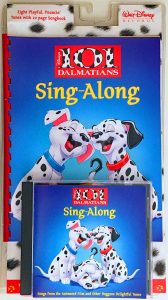 As far as can be determined, the four Camarata versions of the 101 Dalmatians songs from the 1961 Storyteller, while released on single and EP records, were never issued on CD except by Walt Disney Records Japan on a 1995 disc combining them with Disneyland Records’ 1976 edition soundtrack to Peter Pan (PCCD-00140). However, in 1996 Walt Disney Records (U.S.A.) produced a 101 Dalmatians book and CD package in the Sing-Along series that was a tribute of sorts.
As far as can be determined, the four Camarata versions of the 101 Dalmatians songs from the 1961 Storyteller, while released on single and EP records, were never issued on CD except by Walt Disney Records Japan on a 1995 disc combining them with Disneyland Records’ 1976 edition soundtrack to Peter Pan (PCCD-00140). However, in 1996 Walt Disney Records (U.S.A.) produced a 101 Dalmatians book and CD package in the Sing-Along series that was a tribute of sorts.
Four of the selections on 101 Dalmatians Sing-Along (60910-2) are stereo remakes using Camarata’s arrangements: “Cruella De Vil,” “Kanine Krunchies Kommercial” (with the announcer), the Shermans’ “One Hundred and One Dalmatians” and Teri York’s version of “He’s a Tramp” (though these singers are uncredited). Highly recommended for fans of the score and the ’61 album.
In 2007, an album called Bone-a-fide Hits! (D000117412) was released, combining Sing-a-Long Songs with studio versions of “Doggie in the Window,” Puppy Love,” “My Dog’s Bigger Than Your Dog” and others, plus two music videos. It was followed by another disc of similar material from previous discs entitled 101 Dalmatians and Friends (D000112902), marketed as a “picture disc” because the CD had a color picture that could be seen through the jewel case cover, as the insert card had been removed. Discs like these were usually sold through special arrangements with retailers and to promote home video reissues.
“Dalmatian Plantation” (Sing-Along Version)
This a studio chorus version of song heard in the movie, not the album one with the alternate melody and lyrics—but unlike the movie, this rendition has additional lyrics. Mel Leven wrote all the versions.
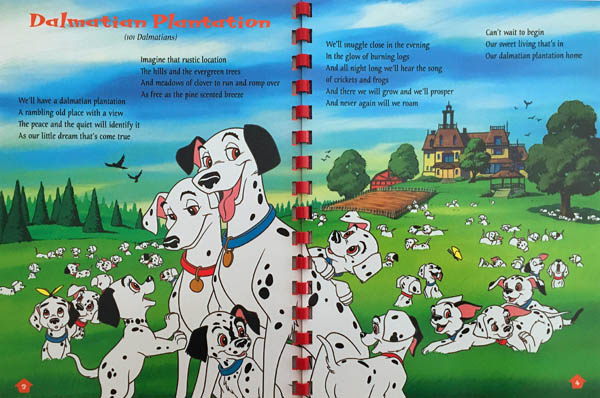
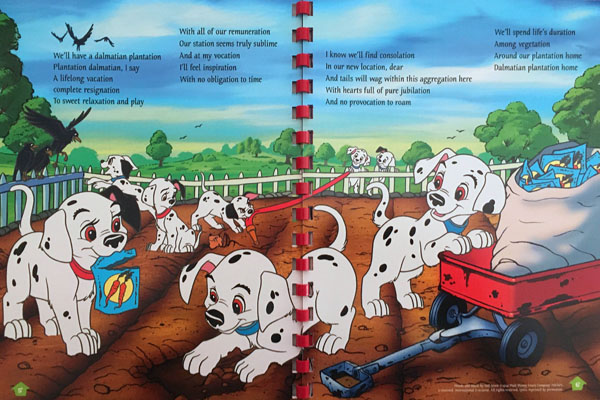


 GREG EHRBAR is a freelance writer/producer for television, advertising, books, theme parks and stage. Greg has worked on content for such studios as Disney, Warner and Universal, with some of Hollywood’s biggest stars. His numerous books include Mouse Tracks: The Story of Walt Disney Records (with Tim Hollis). Visit
GREG EHRBAR is a freelance writer/producer for television, advertising, books, theme parks and stage. Greg has worked on content for such studios as Disney, Warner and Universal, with some of Hollywood’s biggest stars. His numerous books include Mouse Tracks: The Story of Walt Disney Records (with Tim Hollis). Visit 





















































I have the CD soundtrack of “101 Dalmatians” and I love it! George Bruns is one of my favorite composers. I hope someday they’ll release his scores for “The Love Bug,” “The Sword in the Stone” and the two Davy Crockett movies on CD.
What is truly worthy will eventually get through and will last.
I’m not surprised that it took Disney so long to release the soundtrack album. The film only has three songs, all of which are brief or fragmentary. While it boasts a fine musical score, the music is so closely tied to the action onscreen that a record version would probably require additional narration, which would only obscure the music further. The opening title sequence is outstanding — I especially like the way the Dalmatian spots turn into notes on a staff during the music credits, and how the letters in the Effects Animators’ names twinkle and shimmer — but to play the soundtrack on its own as a sort of overture, without the visual reference, might tend to sound disjunct and chaotic. Evidently Randy Thornton had his work cut out for him.
I notice that in the illustration accompanying the “Dalmatian Plantation” lyrics, Pongo is wearing a blue collar and Perdita a red one; but in the movie, the male dogs wear red and the females wear blue. But hey, if a couple wants to get up to that freaky stuff in the privacy of their own plantation, that’s their own business.
Though the tune is altogether different from the version on the original storyteller album, this version of “Dalmatian Plantation” has much of the same ambiance as the other recording. Similar chorus, with banjos dripping in the background, and laid-back lyrics set to a leisurely beat. Each one is a classic in its own right. I think, having listened to it, that I prefer this one. The little snippet of the song that is heard at the end of the film is more of a teaser that never really delivers what it promises, and consequently I always preferred the alternate version of the song. Now I’m enchanted with the film tune, as expanded into a full song the way it’s done here. Thanks for sharing that piece! Gets the day off to a great start!
I have the ”Disneyland Storyteller” edition as well as the cd soundtrack. I agree completely about the ”Dalmatian Plantation” version of the song heard on the storyteller album. I love it, and prefer it to the one used in the film. The same goes for the storyteller version of ”Playful Melody”. It’s a shame that both of those renditions didn’t find their way into the film.